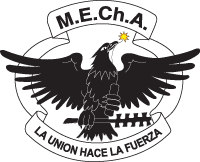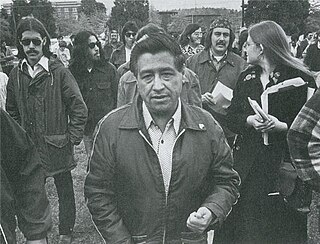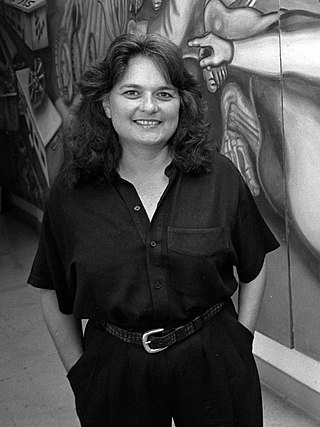Related Research Articles

M.E.Ch.A. is a US-based organization that seeks to promote Chicano unity and empowerment through political action.

Chicanismo emerged as the cultural consciousness behind the Chicano Movement. The central aspect of Chicanismo is the identification of Chicanos with their Indigenous American roots to create an affinity with the notion that they are native to the land rather than immigrants. Chicanismo brought a new sense of nationalism for Chicanos that extended the notion of family to all Chicano people. Barrios, or working-class neighborhoods, became the cultural hubs for the people. It created a symbolic connection to the ancestral ties of Mesoamerica and the Nahuatl language through the situating of Aztlán, the ancestral home of the Aztecs, in the southwestern United States. Chicanismo also rejected Americanization and assimilation as a form of cultural destruction of the Chicano people, fostering notions of Brown Pride. Xicanisma has been referred to as an extension of Chicanismo.
El Grito del Norte was a bilingual newspaper based in Española, New Mexico, co-founded by the activist Elizabeth "Betita" Martinez and the attorney Beverly Axelrod in 1968. Before this, Martínez had worked with social issues such as the black movement and the Student Nonviolent Coordinating Committee while Axelrod had been involved in the first production of The Black Panther. The tabloid was originally the publication of the Reies Tijerina's Alianza Federal de Mercedes, an organization dedicated to recovering the lands of dispossessed Hispanos, whom Axelrod represented as a lawyer. It expanded to provide coverage of the Chicano Movement in urban areas, workers' struggles and Latino political prisoners, as well as other Leftist causes. The paper often advocated for the advancement of such minority groups as well as the Black and Native American communities.

The Chicano Movement, also referred to as El Movimiento, was a social and political movement in the United States that worked to embrace a Chicano/a identity and worldview that combated structural racism, encouraged cultural revitalization, and achieved community empowerment by rejecting assimilation. Chicanos also expressed solidarity and defined their culture through the development of Chicano art during El Movimiento, and stood firm in preserving their religion.

Chicana feminism is a sociopolitical movement, theory, and praxis that scrutinizes the historical, cultural, spiritual, educational, and economic intersections impacting Chicanas and the Chicana/o community in the United States. Chicana feminism empowers women to challenge institutionalized social norms and regards anyone a feminist who fights for the end of women's oppression in the community.

Judith Francisca Baca is an American artist, activist, and professor of Chicano studies, world arts, and cultures based at the University of California, Los Angeles. She is the co-founder and artistic director of the Social and Public Art Resource Center (SPARC) in Venice, California. Baca is the director of the mural project that created the Great Wall of Los Angeles, which was the largest known communal mural project in the world as of 2018.

Chicana literature is a form of literature that has emerged from the Chicana Feminist movement. It aims to redefine Chicana archetypes, in an effort to provide positive models for Chicanas. Chicana writers redefine their relationships with what Gloria Anzaldúa has called "Las Tres Madres" of Mexican culture, by depicting them as feminist sources of strength and compassion.
Hijas de Cuauhtémoc was a student Chicana feminist newspaper founded in 1971 by Anna Nieto-Gómez and Adelaida Castillo while both were students at California State University, Long Beach.

Maria Teresa "Teresita" Sandoval Suazo (1811–1894) was among the first women of European heritage to live in the Arkansas Valley of present-day Colorado. She is one of the founders of El Pueblo in the current city of Pueblo, Colorado. She managed a ranch, the Doyle Settlement, in her later years.

Chicana art emerged as part of the Chicano Movement in the 1960s. It used art to express political and social resistance through different art mediums. Chicana artists explore and interrogate traditional Mexican-American values and embody feminist themes through different mediums such as murals, painting, and photography. The momentum created from the Chicano Movement spurred a Chicano Renaissance among Chicanas and Chicanos. Artists voiced their concerns about oppression and empowerment in all areas of race, gender, class, and sexuality. Chicana feminist artists and Anglo-feminist took a different approach in the way they collaborated and made their work during the 1970s. Chicana feminist artists utilized artistic collaborations and collectives that included men, while Anglo-feminist artists generally utilized women-only participants. Art has been used as a cultural reclamation process for Chicana and Chicano artists allowing them to be proud of their roots by combining art styles to illustrate their multi-cultured lives.
Rita Martinez was a Chicana activist operating in Pueblo, Colorado.
Charlene Garcia Simms is a teacher-librarian from Garcia, Colorado. She and her husband founded El Escritorio Publishing which focuses on Southwest history and genealogy.
Las Madres de la Casa Verde were a group of Chicana women in Pueblo, Colorado that formed to support the Chicano community in the lower eastside. They worked closely with other activist groups such as La Raza Unida and the Brown Berets.
Martín Porferio "Marty" Serna was an early organizer of the Chicano Movement, who was one of the founders of the Brown Berets in Pueblo, Colorado. He was part of the La Raza Unida political party, and developed several community organizations in Pueblo including the Black/Brown Berets, United Farmworkers Organization, Escuela Huitzhualopán, Southern Colorado Chicano Planning Council, and El Partido de la Raza Unida.
La Cucaracha (1976-1983) was an English and Spanish bilingual newspaper created by and for the Chicano community of Pueblo, Colorado. Creators Juan Espinosa, Deborah Espinosa, David Martinez and Pablo Mora recognized the exclusion of Chicanos in popular media and published the first issue in 1976.
Shirley Romero Otero is a Chicana activist who co-founded the Land Rights Council in 1977 to regain the rights for heirs of the Sangre de Cristo Land Grant. She is an educator and leader in the San Luis Valley region. She is the director of the Move Mountains Youth Project and sits on the board of directors of the Acequia Institute.
Carmen Roybal Arteaga is a Pueblo-based activist for Chicano education and historical research. She has been an advocate for bilingual and bicultural education in Pueblo schools to meet the needs of the large Chicano population. She was also known as Carmen Serna when she was married to activist Martín Serna.
Deborah Martinez-Martinez is CEO of the publisher Vanishing Horizons and is an author who explores the history of the Southwestern United States. She worked in higher education admissions and recruitment for twenty years and advocates for more Chicanas in education.

A Chicano mural is an artistic expression done, most commonly, on walls or ceilings by Chicanos or Mexican-American artists. Chicano murals rose during the Chicano art movement, that began in the 1960, with the influence of Mexican muralism and the Mexican Revolution. The murals are an illustration of Chicano’s ethnic pride or a form of activism against police brutality, social issues, political issues, and civil rights issues. It started being done by young Chicano artists in commonly marginalized neighborhoods, schools, and churches, demonstrating cultural art and ideas. The murals are characterized by their art style of bright color, religious symbols, and cultural references to Mexican and Mexican American history. Chicano murals have been and are historically found in the Southwest states like Texas, Colorado, and most famously, California, where the national landmark Chicano Park is located. The popularity of the Chicano Murals has allowed a sense of community, culture, activism, and storytelling about elements of being Chicano. Various states are currently looking to preserve and restore some murals as they carry historical meaning for the geographical community and the Mexican-American community.
Priscilla Falcón is a Professor Emeritus of Chicano/a and Latinx Studies at University of Northern Colorado and a Chicana activist. She also publishes under the name Priscilla Falcon-Lujan. After her husband Ricardo Falcón was murdered, she became an outspoken activist for the Chicano/a Movement.
References
- 1 2 3 Martinez Martinez, Deborah (2020). Chicana Activists of Colorado: Powerful women paper dolls and their stories. Pueblo, CO: Vanishing Horizons.
- 1 2 3 Quintana, Praxedes (20 April 2018). Colorado Comadres of the Chicano Movement: Women, Activism, and Motherhood in Pueblo, Colorado (Thesis). Bryn Mawr. Retrieved 9 May 2022.
- 1 2 3 4 5 6 7 8 Ruiz, Vicki L (2006). Latinas in the United States, set: a Historical Encyclopedia.
- ↑ Latch, Lacey (2 February 2022). "CSU Pueblo exhibit explores La Cucaracha, local newspaper that covered Chicano movement". The Pueblo Chieftain.
- ↑ "History Colorado Opens El Movimiento: The Chicano Movement in Colorado". History Colorado.